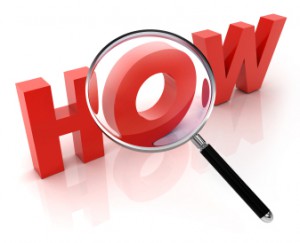Fall Mortgage Market Update (2010)
October 6, 2010Fixed-rate Collateral Mortgages: Good for Banks, Not for Customers
October 20, 2010Welcome to Part Two of my post on How to Make Your Mortgage Tax Deductible. In Part One, we showed that setting up a tax-deductible mortgage is perfectly legal and explained the mechanics of how to structure one. Now that we have established the basics, we will look at which Canadian home owners are best suited to employ this approach an d we’ll address some of the questions that come up. If you have other questions that aren’t discussed in this post, just contact me directly.
d we’ll address some of the questions that come up. If you have other questions that aren’t discussed in this post, just contact me directly.
In theory, anyone who owns a property and has a mortgage can make their loan tax deductible, but in reality there are some limitations. Let’s focus first on mortgagors who have no non-registered investments at this time. For this group, a readvanceable home-equity line-of-credit (HELOC) that increases as mortgage principal is paid down is a vital tool, and these products are available only to borrowers who have at least 20% equity in their property. The HELOC allows you access to your home equity as you pay down your mortgage and without it, there is no way to unlock, and invest, the principal you are paying off with each scheduled payment. If you haven’t yet reached the 20% equity threshold, it’s best to focus on paying down your mortgage until you do.
If you have borrowed 80% or less of the registered value of your property then you have to make a subjective call on what you want your personal balance sheet to look like. Each dollar of mortgage principal that you pay off can either be kept as home equity, or reborrowed as investment capital (with the reborrowed and properly invested portion automatically converting to tax-deductible debt). At the most basic level, you must be confident that you can invest in a CRA  eligible asset that will earn you a return that is greater than the cost of your tax-deductible interest. For example, if we assume that your marginal tax rate is 40%, and that your mortgage interest rate is 5%, then the converted, tax-deductible part of your mortgage interest will cost you 3% (5% less the tax you have saved). Therefore, for you to be better off, you would need to be investing in assets that produce a return higher than 3%. Keep in mind that because your new investments are made outside of your RRSP, any dividends, interest and capital gains will also be subject to taxes, and these costs will have to be factored in as well. This is one of the many reasons why I strongly encourage anyone who is considering a tax-deductible mortgage strategy to partner with a top-notch financial planner.
eligible asset that will earn you a return that is greater than the cost of your tax-deductible interest. For example, if we assume that your marginal tax rate is 40%, and that your mortgage interest rate is 5%, then the converted, tax-deductible part of your mortgage interest will cost you 3% (5% less the tax you have saved). Therefore, for you to be better off, you would need to be investing in assets that produce a return higher than 3%. Keep in mind that because your new investments are made outside of your RRSP, any dividends, interest and capital gains will also be subject to taxes, and these costs will have to be factored in as well. This is one of the many reasons why I strongly encourage anyone who is considering a tax-deductible mortgage strategy to partner with a top-notch financial planner.
If this is starting to sound complicated and if that’s got you thinking “why bother?” now is probably a good time to highlight two elements in this strategy that can dramatically alter your financial future: compounding and time. These two elements form the secret sauce of wealth creation. Compounding basically means that you are reinvesting the money you make from your investments back into your investments, and the longer you do this, the more exponential the impact. The more time you have to own an asset, the more impact compounding will have. Using the convention al approach of paying off your mortgage and then building an investment portfolio costs you too much time, and a creative technique that removes this limitation can dramatically alter your ability to build wealth.
al approach of paying off your mortgage and then building an investment portfolio costs you too much time, and a creative technique that removes this limitation can dramatically alter your ability to build wealth.
One could also argue that leverage is the third key to wealth creation. When you think about it, most retirees today have built a nest egg from their house, which has grown in value for decades. Without leverage, most of that gain would have been impossible. Today, borrowing against our primary residence is still the only way for most of us to achieve any kind of meaningful leverage, but what’s changed, thanks to original thinking by people like Fraser Smith, is that now you have the option of reborrowing your home equity to invest at tax-deductible interest rates and to convert your existing leverage into a cheaper more diversified form.
While I have focused mainly on borrowers with at least 20% equity in their homes who want to start building an investment portfolio from the ground up, those with more equity, and/or with existing non-registered investments, are even better suited to consider this strategy. In fact, the people who stand to benefit the most from making their mortgage tax deductible are those who have more of both. Basically, in thirty days they can own the same house  and the same assets with fully tax-deductible interest. Bluntly put, if you’re in this group, what are you waiting for?
and the same assets with fully tax-deductible interest. Bluntly put, if you’re in this group, what are you waiting for?
If this post has piqued your interest in making your mortgage tax deductible and in converting your mortgage equity into investment capital, I recommend that you read The Smith Manoeuvre. Although some of the references are a bit out of date (like the assumed average annual investment return of 10%), by the end of the book, you’ll be well informed. If you want a recommendation for a financial planner, I am lucky enough to know several and if you want advice about a good HELOC or readvanceable mortgage, I’d be happy to help. To close today’s post, here are five questions frequently asked by people considering this strategy.
1. Am I increasing my leverage (isn’t that risky)?
Employing the basic technique does not include any additional leverage. It just makes the cost of leverage cheaper, and you can be entirely cash neutral if you use each reborrowed principal payment to first pay interest on the line of credit. The “risk” is that you are converting part or all of your home equity into investment equity. That’s a personal decision you have to be comfortable with.
2. Are all HELOCs the same?
No. Some home-equity lines of credit give borrowers a single account and others can be split into sub-accounts. The sub-account HELOCs are preferred because it’s easier to file your taxes when all of your investment borrowings are clearly separated from other, non-deductible uses of credit. (And then, of course, there’s also often a difference in the offered rate.)
3. Should I sell my RRSPs to execute this strategy?
I would vote no. I like the RRSP’s tax-free compounding and once you take the money out, you can never put it back in. I’d leave it alone.
4. What impact do today’s low rates have on using this approach?
With rates at today’s levels your savings from interest deductibility are lower than they would be at higher rates. If you convert a variable mortgage to a readvanceable line of credit, you will have to pay a somewhat higher rate. Today, an average variable-rate mortgage would cost about 2.4% (prime -.60%), while a well priced line of credit comes in at 3.5% (prime + .50%). If you’re in the 40% marginal tax bracket, then your line-of-credit net cost is 2.1% (which is 3.5% minus the tax savings). Compared to your previous 2.4% rate, that’s a savings of only .3%. True. But consider that this savings will only grow if and when rates start to rise, and remember Fraser Smith’s observation that two-thirds of the effect comes from the benefit of owning your investments now instead of later. About one-third of the benefit is the effect of converting to tax-deductible interest.
5. Does making my mortgage interest tax-deductible affect my capital gains exemption when I sell my house?
No. In fact, just to be extra clear, double no.








12 Comments
Nice and pretty revealing article. I have a Heloc account but it unfortunately does not have a sub-account. I am however curious to know if I can still use funds from this acct for investment if my bank says its not possible to create a sub-acct (strictly for investment) from my current Heloc. I currently enjoy a highly discounted rate of 2.2% (will increase to 2.7% after April 2017) on my Heloc and am looking at investing in mortgage investments offering average 10% interest. Does borrowing money from my Heloc low interest of 2.2% make sense when its obvious that interest from my investment will impact the income I report in my taxes rather significantly. I currently make about $100,000 a year.
Mide
Hi Olumide,
You don’t need to have a sub-account for your HELOC in order to be able to deduct the interest expense. As long as you can clearly show that the funds were used for eligible investments you will be fine (the sub-account just makes the flow of funds easier to track and report).
As to whether borrowing money on your HELOC makes sense, I don’t have enough information on your specific investments and on your personal circumstances to offer an opinion on that question.
Best regards,
Dave
Hi Dave,
Can you follow the same strategy without a HELOC? For example, refinance home to increase mortgage from $50k to $100k, and immediately contribute the extra $50k into an RRSP?
Thanks!
Hi InvestGuy,
It doesn’t matter if you borrow the money using a HELOC or a mortgage. It is what you do with that money that determines whether or not the interest is tax deductible.
On a related note, you can’t tax deduct interest on money invested in an RRSP (because you already get a tax break on money contributed to an RRSP). Basically you can’t double dip!
Best,
Dave
Hi Dave,
I used the HLOC of my house A as the part of the down payment to buy a new house B. Then I moved from A to B and rent A house out. Is the interest of HLOC on house A tax deductible?
Thanks,
Hanson
Hi Hanson,
It is the use of the funds that determines whether or not the interest is tax deductible.
As such, if you are using the funds from house A to buy house B, and if you are going to be living in house B, the interest would not be tax deductible.
Best,
Dave
Hey Dave, I do not have a mortgage on house A. I want to buy a newer house B in the near future, designate it my new principal residence, and rent house A. How can I get structure the purchase in order to deduct interest on house A (to offset the rent income)?
Alternative question:
Suppose I have a principal residence with a $ 300K mortgage. If I start renting it out next year, can I deduct the mortgage interest and offset it against the rental income ?
To address the first situation, can I then refinance my house with a $ 300K mortgage, and in a couple of years, start renting it out so that I can deduct the mortgage interest to offset the rental income ?
Thank you
Hi Peter,
If you are using the money borrowed against house A to buy house B, and if house B is going to be your principal residence, then there is no way to structure the loan to make the mortgage interest tax deductible.
It is the use of the funds, not the property they are borrowed against, which determines whether the interest can be tax deductible. As such, any money borrowed for the purchase of buying a principal residence would never be eligible.
In answer to your other question, if you convert a property from being your principal residence to a rental property then the interest would be tax deductible for that day forward (but on the flip side, at that point the property would no longer be eligible for the capital-gain exemption applied to principal residences).
Best regards,
Dave
Hi Dave,
I have a tax question about the interest deduction for rental income.
Assume that House A is my principle residence, and Condo B is my investment property. I have 100K HELOC on House A. The mortgage rate on Condo B is very high.
I would like to allocate 100K HELOC to a new mortgage segment with much lower interest rate, and use this 100K to prepay the mortgage on Condo B. No prepayment penalty will be introduced. In this case, can I deduct the interest cost on 100K mortgage for tax?
Thanks,
Feng
Hi Feng,
You would be able to deduct the interest as long as you could show a complete paper trail to confirm that the funds were originally used to purchase the investment property.
Best,
Dave
Hello Dave, very interesting article. However I have a question about HELOC on rental property. Does CRA allows to deduct interest from rental property against investments like Stocks and Mutual funds. Let’s say HELOC interest is 2.95% now,investments will generate 5% return ,marginal tax rate is 20%.
Thank you,Robert
Hi Robert,
If you are using a HELOC on your rental to purchase investments then the interest should be tax deductible provided that the investments either pay a dividend or have a realistic prospect of paying a dividend. (To be sure, I suggest that you ask your financial advisor or call CRA to confirm.)
Best,
Dave